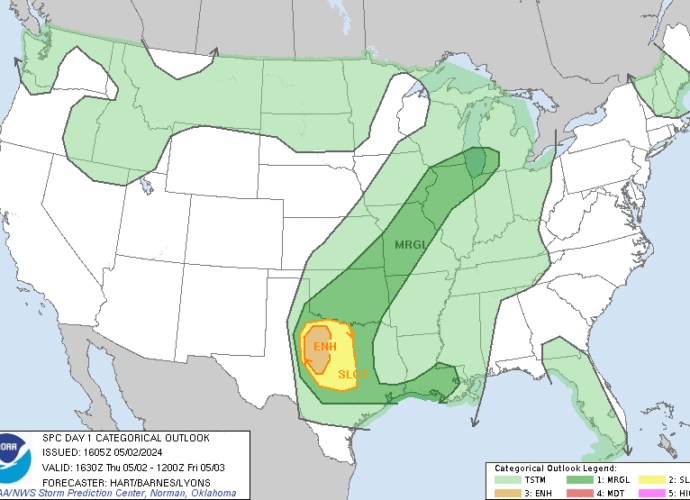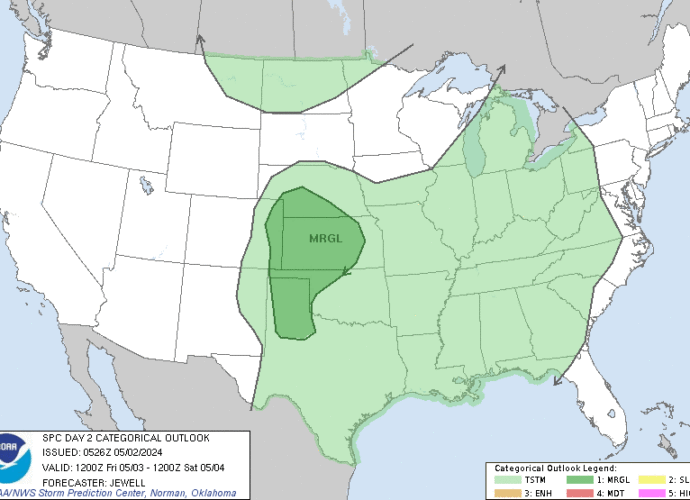SPC MD 525
2024-04-26
SPC Mesoscale Discussions
MD 0525 CONCERNING SEVERE POTENTIAL…WATCH POSSIBLE FOR CENTRAL NORTHEAST TEXAS
Mesoscale Discussion 0525
NWS Storm Prediction Center Norman OK
0933 AM CDT Fri Apr 26 2024
Areas affected...central northeast Texas
Concerning...Severe potential...Watch possible
Valid 261433Z - 261700Z
Probability of Watch Issuance...60 percent
SUMMARY...Scattered storms are likely to form throughout the day,
and some are likely to become severe with tornado and large hail
potential. A watch may be needed by midday.
DISCUSSION...The morning FWD sounding shows a deep moist layer early
this morning, with 50 kt winds below 850 mb resulting in strong
low-level shear. Satellite imagery shows broken to overcast
conditions over much of central TX, with scattered to broken over
much of northern TX, leading to areas of heating.
The very moist air mass is already aiding early development of
storms between Austin and Stephenville, and indications are that
this activity will gradually increase during the day beneath a
persistent low-level jet. This will lead to a long duration of
moist, unstable and sheared environment, with a few supercells
likely within the developing cluster of warm sector storms, leading
to a developing tornado risk as the activity spreads toward
northeast TX.
..Jewell/Hart.. 04/26/2024
...Please see www.spc.noaa.gov for graphic product...
ATTN...WFO...SHV...TSA...HGX...FWD...OUN...
LAT...LON 31109646 31039777 31339853 31749866 32329848 32719829
33129802 33729636 33949543 33859483 33749425 33609404
33349396 32859407 32099463 31799507 31109646
https://www.spc.noaa.gov/products/md/md0525.htmlSPC Mesoscale Discussions
SPC Apr 26, 2024 1300 UTC Day 1 Convective Outlook
2024-04-26
SPC 1300Z Day 1 Outlook
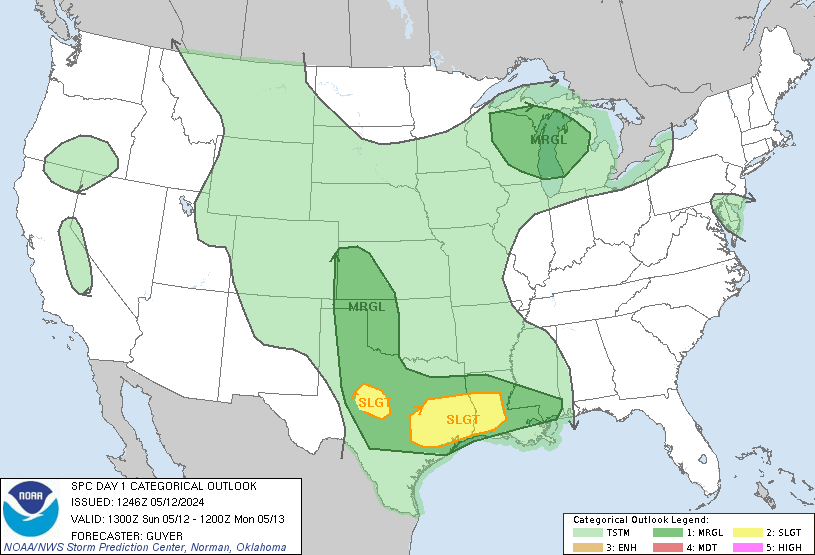

Day 1 Convective Outlook NWS Storm Prediction Center Norman OK 0753 AM CDT Fri Apr 26 2024 Valid 261300Z - 271200Z ...THERE IS AN ENHANCED RISK OF SEVERE THUNDERSTORMS THIS AFTERNOON/EVENING ACROSS NORTHEAST KS/SOUTHEAST NE/NORTHWEST MO/SOUTHWEST IA... ...SUMMARY... A few tornadoes, including a couple of strong tornadoes, isolated very large hail (greater than 2 inch diameter) and isolated wind damage will be possible, mainly this afternoon/evening from northeast Kansas/southeast Nebraska into northwest Missouri and southwest Iowa. Occasional severe storms are expected farther south into Arkansas, eastern Oklahoma and northeast Texas. ...Mid MO Valley to TX through tonight... A complex surface pattern is evident this morning with a cyclone in northern KS, a trailing dryline/Pacific front into western OK, and the east edge of the warm sector demarcated by a warm front from eastern OK into eastern KS. An ongoing QLCS with occasional wind damage and tornado reports is moving across eastern OK near the warm front, with an area of rain-cooled/overturned in OK in the wake of these storms. Farther north, an undisturbed portion of the warm sector extends across central KS. The eastern OK convection will likely persist through the day toward western AR, with additional expansion of rain/thunderstorms farther northeast into southwest/central MO. The OK/AR portion of this convection will be the most likely to maintain access to the surface warm sector through the day, where a mix of bowing segments or embedded supercells will be possible with all hazards. The clouds/rain will slow the northeastward progress of the warm sector, and northward advection of the overturned airmass in OK will potentially impact the breadth and quality of the unstable warm sector this afternoon. Assuming sufficient recovery during the day, there will be a window of opportunity for tornadic supercells along the dryline this afternoon/evening starting in northeast KS/southeast NE and spreading into northwest MO/southwest IA. MLCAPE at or above 2000 J/kg, boundary-layer dewpoints in the mid 60s, and sufficiently long hodographs with low-level hodograph curvature (effective bulk shear in excess of 50 kt, and effective SRH of 200-300 m2/s2) suggest the potential for a couple of strong tornadoes with any persistent, semi-discrete supercells. Isolated very large hail (in excess of 2 inches in diameter) will also be possible, while the potential for a few damaging gusts will accompany any upscale growth into line segments this evening. Additional thunderstorm development will be possible today farther southwest into TX, in association with weak height falls on the southern fringe of the ejecting midlevel trough. The 12z FWD sounding showed only a weak cap, so the SLGT has been expanded some to the southwest to account for large hail/wind damage potential today. Storms will likely weaken by this evening as weak height rises commence and the remnant dryline begins to retreat to the west. ..Thompson/Guyer.. 04/26/2024
SPC Apr 26, 2024 0600 UTC Day 1 Convective Outlook
2024-04-26
SPC 1200Z Day 1 Outlook
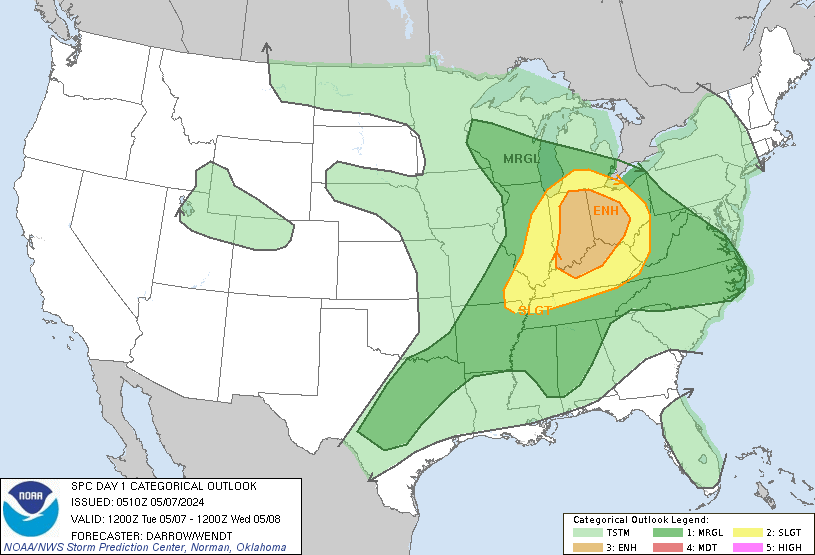

Day 1 Convective Outlook NWS Storm Prediction Center Norman OK 1225 AM CDT Fri Apr 26 2024 Valid 261200Z - 271200Z ...THERE IS AN ENHANCED RISK OF SEVERE THUNDERSTORMS ACROSS PARTS OF THE LOWER TO MID MISSOURI VALLEY...AND CENTRAL PLAINS... ...SUMMARY... Severe thunderstorms will be likely today from parts of eastern Nebraska into western and central Iowa, southward into eastern Kansas and Northwest Missouri. All hazards will be possible, including tornadoes with some potentially strong, very large hail over two inches in diameter, and wind damage. A more isolated severe threat will extend south-southwestward into parts of the southern Plains, Ozarks and Ark-La-Tex from late afternoon into the evening. ...Significant Severe Weather Event Expected Today Across Parts of The Lower To Mid Missouri Valley and Central Plains... ...Lower to Mid Missouri Valley/Central Plains... A negatively tilted upper-level trough will move northeastward across the mid Missouri Valley today, as an associated 50 to 60 knot mid-level jet translates northeastward through the base of the system. At the surface, a low will deepen and move northeastward across Nebraska. A north-to-south corridor of maximized low-level moisture, with surface dewpoints in the mid 60s F, will be in place by midday across eastern Kansas and southeast Nebraska. Moderate instability will develop across most of the moist sector by afternoon, with thunderstorms first developing in east-central Nebraska around midday. These storms are expected to move eastward across eastern Nebraska during the afternoon, as convective coverage gradually expands south-southeastward into eastern Kansas. The environment will be favorable for severe storms, with several clusters moving eastward from Nebraska into Iowa, and from Kansas into Missouri during the late afternoon and early evening. Several factors appear to be supportive of a significant tornado event today across eastern part of the central Plains into the lower to mid Missouri Valley. The first is that a 60 to 70 knot mid-level jet, associated with a negatively tilted trough, will become coupled with a 50 to 60 knot low-level jet over a moist and unstable warm sector. A second factor is that a band of large-scale ascent will move over the warm sector this afternoon, as the capping inversion diminishes. Steep low to mid-level lapse rates are forecast to spread over the warm sector, which combined with moderate deep-layer shear, will be favorable supercells with strong updrafts at relatively low-levels within the storms. In addition, 0-3 km storm-relative helicity is forecast to increase into the 300 to 400 m2/s2 range along the western edge of the low-level jet, which will be favorable for strong tornadoes. A few tornadic supercells are expected, with the greatest potential from near Omaha eastward to near Des Moines and southward to south of the Kansas City Metro. Along this corridor, the more dominant supercell storms will also have a potential to produce hailstones greater than 2 inches in diameter and wind damage. The severe threat is expected to shift eastward across Iowa and Missouri during the mid to late evening, with an isolated severe threat continuing after midnight. ...Southern Plains/Ozarks/Ark-La-Tex... Southwesterly mid-level flow will be in place today across the south-central U.S., with a broad moist warm sector located from the southern Plains eastward into the Ark-La-Tex and Ozarks. An MCS is expected to move across central and eastern Oklahoma during the morning, which will stabilize the airmass. However, instability is forecast to redevelop across Oklahoma by afternoon. Further south, strong instability is expected to develop across much of central and east Texas by afternoon, where MLCAPE should peak in the 2500 to 3500 J/kg range. Although large-scale ascent will be weak across most of the southern Plains, the cap is expected to diminish and isolated thunderstorms appear likely to develop by late afternoon. A severe threat is expected to persist along and near the instability axis during the early to mid evening. RAP forecast soundings at 00Z/Saturday along and near the instability axis from southeast/south-central Oklahoma into north-central Texas have 0-6 km shear between 40 and 50 knots. Low to mid-level lapse rates will become steepest in areas that heat up the most. The environment will likely be favorable for isolated supercells with large hail. By late afternoon, forecast soundings also have 0-3 Km storm-relative helicity reaching 200 m2/s2 suggesting that an isolated tornado threat will be possible. The tornado threat is expected to be the greatest across eastern Oklahoma, northeast Texas and western Arkansas, as the low-level jet ramps up in the early evening. Wind damage will also be possible with storms that develop. ..Broyles/Thornton.. 04/26/2024
SPC Apr 26, 2024 0600 UTC Day 2 Convective Outlook
2024-04-26
SPC 0600Z Day 2 Outlook
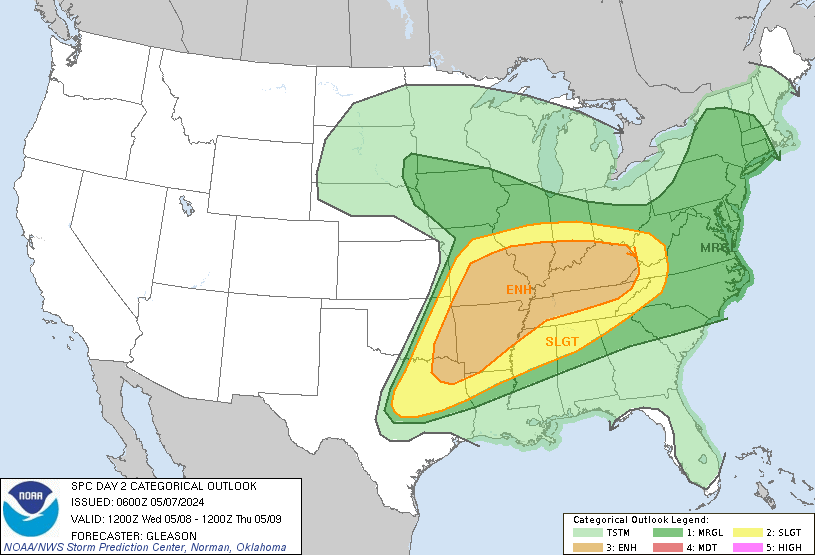

Day 2 Convective Outlook NWS Storm Prediction Center Norman OK 1250 AM CDT Fri Apr 26 2024 Valid 271200Z - 281200Z ...THERE IS AN ENHANCED RISK OF SEVERE THUNDERSTORMS FOR MUCH OF OK...PARTS OF NORTH TX...CENTRAL/EASTERN KS...NORTHWEST MO...SOUTHEAST NE...SOUTHWEST IA... ...SUMMARY... Potentially widespread strong to severe thunderstorms are expected Saturday into Saturday night. The greatest threat is currently anticipated across parts of the central and southern Plains, where very large hail, damaging winds, and a few strong tornadoes will be possible. A larger area of potential threat will extend from south-central Texas north-northeastward into the Great Lakes. ...Synopsis... A shortwave trough and attendant surface low are forecast to gradually weaken and move northeastward across the upper Great Lakes region on Saturday. Meanwhile, a deep mid/upper-level trough will move eastward from the Southwest, resulting in a deepening cyclone across southwest KS. Rich low-level moisture will continue to stream northward across the warm sector of this cyclone, and extend northeastward along/ahead of the front into parts of the upper Midwest and Great Lakes. ...Central/southern Great Plains... A complex but potentially significant severe weather episode is expected on Saturday, with the greatest threat currently expected from parts of central/eastern KS into central/western OK and north TX. All severe hazards will be possible, including the threat for strong tornadoes and very large hail. Evolution of the warm sector and storm development on Saturday will be complicated by the potential for early-day convection spreading northeastward from northwest TX through OK into eastern KS. This convection would likely initiate late in the D1/Friday period as low-level moisture streams westward in conjunction with a retreating dryline, beneath steep midlevel lapse rates. While most guidance depicts some sort of early convection, its forecast evolution varies widely among both CAMs and parameterized convection within mesoscale and global models. Some severe threat could accompany this convection as it moves northeastward through the day. Strong low-level southerly flow will support recovery in the wake of any morning convection. Diurnal storm development will be possible in the vicinity of the dryline and also near a northward-moving warm front extending east-northeast from the deepening cyclone. For the dryline regime, supercell development will become increasingly possible by late afternoon, as MLCINH diminishes and some influence of the approaching upper trough begins to overspread the region. Moderate to strong buoyancy and strengthening deep-layer shear will support an initial threat of very large hail (potentially 2-3 inches in diameter). The tornado threat will increase into early evening, due to a notable increase in the low-level jet (and related shear/SRH) with time and eastward extent. Any persistent supercells will pose a threat of strong to potentially intense tornadoes as they move northeastward. Dryline storm initiation may be somewhat greater in coverage from west-central KS into northwest OK, in closer proximity to stronger large-scale ascent, though at least isolated development will be possible into southwest OK and northwest TX. For the warm-front regime, initial development may tend to be focused near the dryline/front intersection across north-central KS, with more isolated initiation possible northeastward along the front as capping is gradually eroded. Moderate to strong buoyancy and favorable low-level and deep-layer shear will support supercell potential within this regime. All severe hazards will be possible, including the potential for very large hail and a strong tornado. With time, increasing storm coverage will likely halt the northward progression of the warm front, with one or more storm clusters moving near/north of the front through the evening with a continued severe threat. Aside from the dryline and warm-frontal regimes, diurnal development across the broader warm sector will be possible within a moist and weakly capped environment, particularly from central OK into eastern KS. Evolution and coverage of diurnal warm sector development remain uncertain, but the environment will support supercell development with a threat of tornadoes and very large hail. Storm coverage will likely increase into the evening, as large-scale ascent attendant to the approaching shortwave trough overspreads the region. Convection may tend to organized into a QLCS overnight. While magnitude of the severe threat with overnight convection remains uncertain, favorable moisture and a strong low-level jet may continue to support at least some threat for all severe hazards, both within the warm sector and eventually along a trailing cold front into parts of central/southwest TX. ...Northwest KS/southwest NE into northeast CO... Low-level easterly flow will maintain modest low-level moisture within the post-frontal regime from northwest KS/southwest NE into northeast CO. Steep midlevel lapse rates will support MLCAPE increasing to near/above 500 J/kg, with veering wind profiles supporting potential for organized convection. A supercell or two could evolve within this regime, with an attendant threat of large hail and possibly a brief tornado. ...Parts of the Upper Midwest/Great Lakes... A separate regime of at least isolated severe-thunderstorm potential remains evident along/ahead of the cold front from eastern IA into parts of the Great Lakes region. While the influence of the ejecting shortwave trough initially over the Upper Great Lakes may remain mostly displaced from the warm sector, diurnal heating/destabilization and decreasing CINH may support isolated storm development by late afternoon along the cold front. Deep-layer shear will remain sufficient for organized convection, supporting conditional potential for supercells and/or stronger clusters capable of producing hail, damaging gusts, and possibly a tornado or two. Some increase in storm coverage will be possible into the evening as the cold front moves southeastward. Eventually, convection should generally weaken overnight across this region, though a stronger cluster to two could move from eastern portions of the central Plains toward the upper MS Valley before the end of the forecast period. ..Dean.. 04/26/2024
SPC Apr 26, 2024 0730 UTC Day 3 Severe Thunderstorm Outlook
2024-04-26
SPC 0730Z Day 3 Outlook


Day 3 Convective Outlook NWS Storm Prediction Center Norman OK 0226 AM CDT Fri Apr 26 2024 Valid 281200Z - 291200Z ...THERE IS A SLIGHT RISK OF SEVERE THUNDERSTORMS FROM NORTHEAST TX INTO PARTS OF THE MID/UPPER MS VALLEY... ...SUMMARY... Strong to potentially severe thunderstorms will be possible Sunday across a broad area from northeast Texas into parts of the upper Mississippi Valley. Large hail, damaging winds, and a couple tornadoes will all be possible. ...Northeast TX into parts of the upper MS Valley... A broad region of at least some severe potential is expected on Sunday from northeast TX into parts of the upper MS Valley. Uncertainty remains high due to the influence of extensive antecedent convection leading into the D3/Sunday period. A negatively tilted shortwave trough and attendant surface low are forecast to move from the central Plains toward the upper MS Valley on Sunday. Extensive convection will likely be ongoing at the start of the period from Texas toward the lower MO Valley, and potentially farther north into parts of the upper Midwest. Some lingering severe threat could accompany this morning convection, especially toward the ArkLaTex region where somewhat more favorable moisture/instability will be in place. Widespread cloudiness/convection across much of the warm sector will tend to limit diurnal destabilization, though deep-layer shear will remain favorable for organized storms, and some heating/destabilization will be possible in the wake of morning convection. One area of potential redevelopment will be immediately ahead of the ejecting shortwave trough from eastern KS into western MO and southern IA, where a few stronger cells/clusters could pose a threat of hail, isolated damaging gusts, and perhaps a tornado. Vigorous redevelopment will also be possible along the western/southern periphery of persistent convection near the ArkLaTex region, where rich moisture and favorable wind profiles could support at least an isolated threat for all severe hazards. Some threat could linger into Sunday night across this area, potentially aided by an upstream low-amplitude shortwave trough that will be approaching the southern Plains. ..Dean.. 04/26/2024


